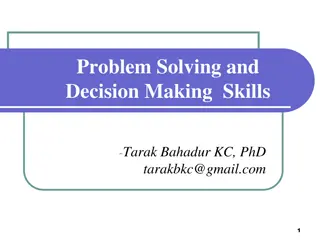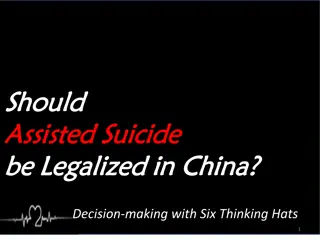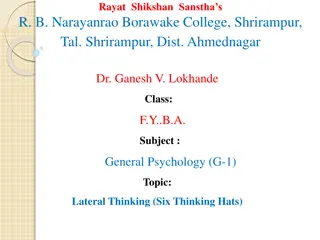Power, Decision Making, and Rules in a School Environment
Explore the dynamics of power, decision-making, and rules within a school setting, analyzing concepts such as Locke's Social Contract, the Stanford Prison Experiment, and the distribution of power among stakeholders like teachers, students, and administrators. Reflect on safety rules, enforcement, and the balance between freedom and safety in a school community. Delve into the importance of rules, who benefits from the current system, and the potential for individuals to exercise power despite appearing powerless.
Download Presentation

Please find below an Image/Link to download the presentation.
The content on the website is provided AS IS for your information and personal use only. It may not be sold, licensed, or shared on other websites without obtaining consent from the author.If you encounter any issues during the download, it is possible that the publisher has removed the file from their server.
You are allowed to download the files provided on this website for personal or commercial use, subject to the condition that they are used lawfully. All files are the property of their respective owners.
The content on the website is provided AS IS for your information and personal use only. It may not be sold, licensed, or shared on other websites without obtaining consent from the author.
E N D
Presentation Transcript
Power and Decision Making in School
Lockes Social Contract You would give up: Some of your rights You gain: Safety and order
Stanford Prison Experiment Trailer 2 http://trailers.apple.com/trailers/ifcfilms/thes tanfordprisonexperiment/
Discussion topic Discuss the use and abuse of power in the experiment. Discuss the use and abuse of enforcement of rules in the experiment.
Look at the following actors in the school community Rearrange them into a triangle with the most powerful at the top and the least powerful at the bottom: Teacher Student Year Head Parent Board of Management Dept. of Education Deputy-principal Student Council Principal Tutor
Looking at safety rules Which rules refer to protecting you, others, the school?
What rules and ways of doing things are considered the best and only way ? Who are the people within schools who benefit most or least because of the way things are organised? Who shapes our ideas on what s the best way of doing things? Can people who appear powerless exercise power?
Homework 1. Using your school journal 1.Examine the rules write out which are, in your opinion, the two most important and the two least important rules? Why? 2.What rules do you think we should take for granted in a school? 3.What is more important for you: freedom or safety? Why?
Looking at other rules un- related to safety For example, school uniform rules, why do we have these?
AUSTRALIA In Australia, each school or school system can set its own uniform policy. Wearing a uniform is compulsory in most Australian private and all Catholic schools, as well as in most public schools, although it is sometimes less enforced in primary schools that have uniforms.
France Since 1968, uniforms have not been enforced in French schools,
Germany There is no tradition to wear school uniforms in Germany, and today, almost all students of state schools, private schools or universities do not wear school uniforms.
Japan Japan introduced school uniforms in the late 19th century. Today, school uniforms are almost universal in the public and private school systems. They are also used in some women's colleges.
United States As of August 2013, almost one fifth of all American schools require their students to wear uniforms The uniform requirement also is more common in lower socio-economic schools. 47% of these low income schools require uniforms, while only about six percent of high socio-economic schools require uniforms.























